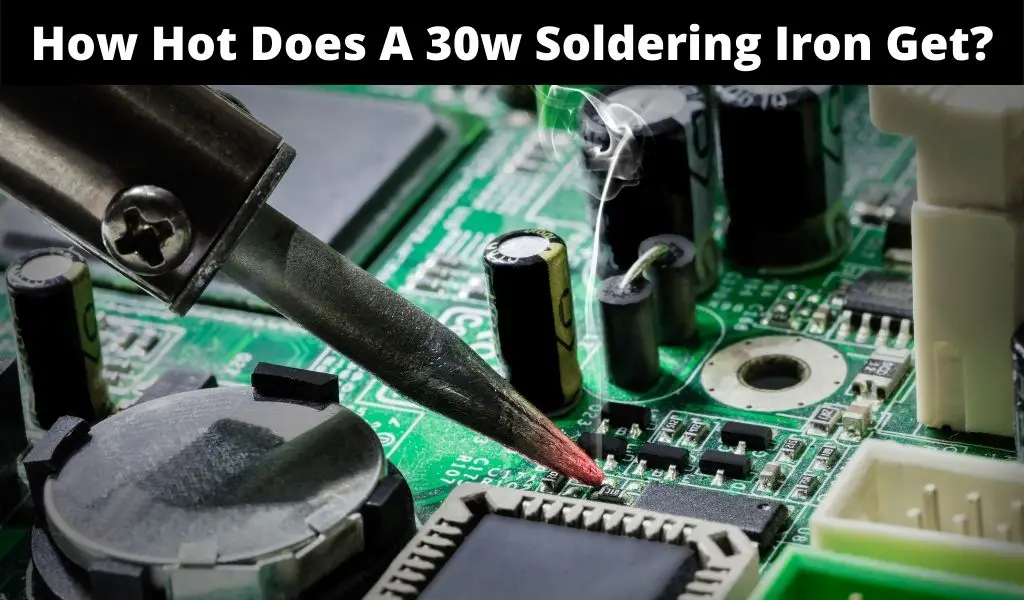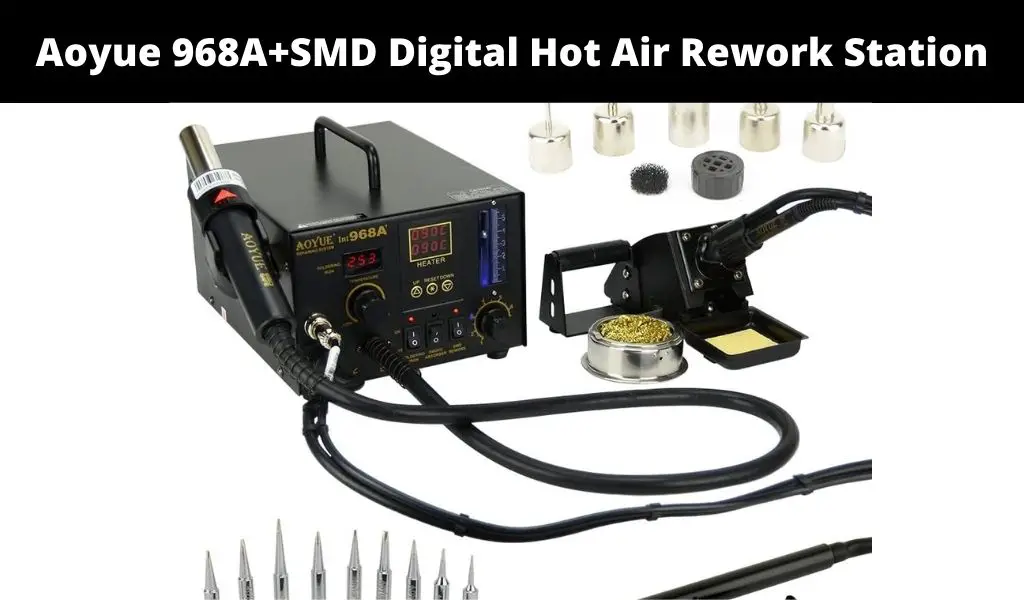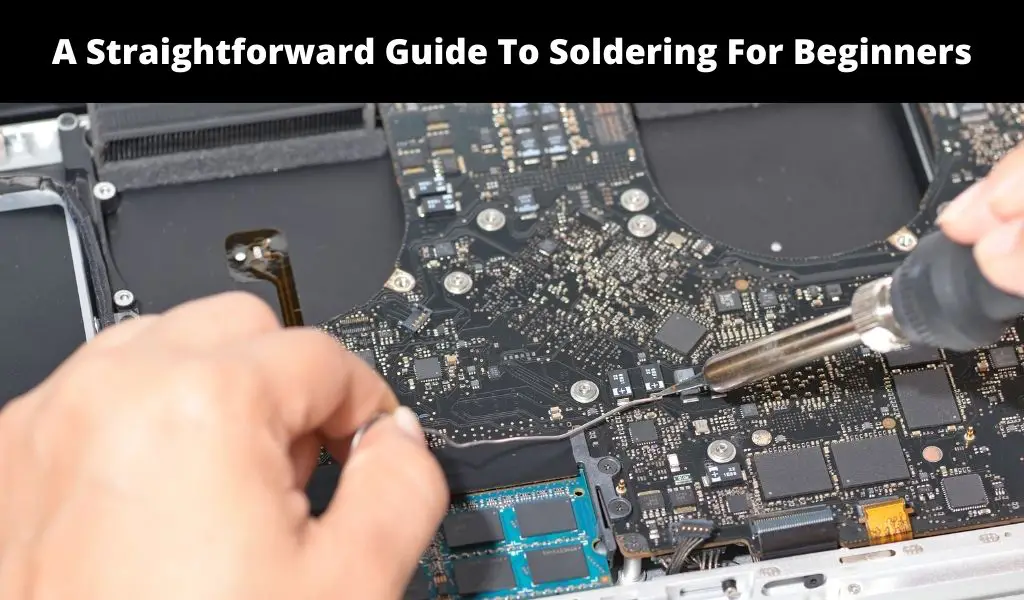Temperature is an important factor when soldering as other factors like the quality of the soldering iron you use or type of solder. If you wish to know how hot a 30w soldering iron gets and other important related information, look no further!
It’s a proven fact that temperature will affect the final quality of a soldering joint. As a result, it’s important to know how hot your soldering iron gets. Ideally, soldering irons shouldn’t get too hot; otherwise, they can damage components. If you must solder at a higher-than-normal temperature, you need a certain skill level.
How Hot Does A 30w Soldering Iron Get?
To answer this question, it’s important to understand the two main categories of soldering irons, namely high and low effect soldering irons.
A 30w solder falls in the low effect soldering iron category. These types of soldering irons must reach higher temperatures than high-effect soldering iron to melt solder. Low effect soldering irons have a wattage ranging from 15w to 30w, while a high effect soldering iron ranges from 40w to 100w. High-effect soldering irons can attain higher temperatures compared to low-effect irons.
Generally, a 30w soldering iron will reach temperatures ranging from 400 to 470 degrees Celsius (752 to 878 degrees Fahrenheit). At these temperatures, the soldering iron can handle most electronic soldering applications. What’s more, a 30-watt iron can maintain hotness better than a soldering iron with lower wattage.
FAQs About Soldering Iron Temperature/Hotness
How Hot Do Lower Wattage Soldering Irons Get?
A 20-w soldering iron can reach temperatures ranging from 350 to 410 degrees Celsius (662 to 770 degrees Fahrenheit). While the temperature range is lower than what a 30-watt iron is capable of, a 20-watt iron can still get the job done, considering solder melts at 180 to 190 degrees Celsius (356 to 374 degrees Fahrenheit).
However, a soldering iron with lower wattage will have a harder time maintaining temperature. Generally, intensive soldering jobs aren’t possible with a 20-watt soldering iron. Ideally, such a soldering iron only gets hot enough for home soldering applications.
A 25-watt soldering iron can attain slightly higher temperatures ranging from 380 to 430 degrees Celsius (716 to 806 degrees Fahrenheit). There’s a huge hotness difference between a 20-watt and 25-watt soldering iron, making the 25-watt iron better for more intensive soldering applications (like soldering motherboards and PCBs).
How Hot Do high Wattage Soldering Irons Get?
A 40-watt soldering iron can reach hotness levels ranging between 440 and 500 degrees Celsius (824 to 932 degrees Fahrenheit). High-effect irons fall in this range or higher and are capable of more intense soldering applications than the typical attaching applications. You can do audio equipment repairs, RC equipment repairs, and other professional-level soldering applications.
A 60-watt soldering iron can reach temperature levels ranging from 470 to 520 degrees Celsius (878 to 968 degrees Fahrenheit). This temperature range is too high for circuit boards. However, a user who chooses to solder with a 60-watt soldering iron can do so perfectly if they are skilled and solder quickly. 60-watt soldering irons aren’t recommendable for electronic applications. They should also be used by experts.
A 100-watt soldering iron can reach temperature levels ranging from 480 to 540 degrees Celsius (896 to 1004 degrees Fahrenheit). Like the 60-watt soldering iron, the 100-watt shouldn’t be used by beginners or electronic applications as it can pose serious risk to circuit boards and other electronic components. A 100-watt soldering iron is perfect for applications such as plumbing and automotive soldering that accommodate high temperatures.
How Do You Tell If a Soldering Iron Has Become Hot Enough?
Many factors dictate soldering iron hotness. For instance, you can know by the wattage and type of soldering iron tip. Generally, the shape and size of the tip will dictate how, first the iron becomes hot. With typical soldering applications, a temperature that can melt solder but doesn’t damage nearby components is a good indicator.
In most cases, hotness is determined via trial and error. You will know your soldering iron is hot enough if you place a piece of solder on the soldering iron or next to the soldering iron. If the solder melts, the soldering iron is ready for use. You can also test with neighboring components in electronic applications. For instance, if the soldering iron damages electronic components nearby (through burn marks or melting on the circuit board), the iron is too hot.
If you have an advanced soldering iron, you can use the temperature control features to know if the soldering iron is hot enough.
Why Is My 30w Soldering Iron Not Getting Hot Enough?
There are many reasons why soldering iron may refuse to reach ideal hotness. The most common reason is damage.
Damage: If your soldering iron tip is damaged, it may take longer to heat up or fail to heat up at all. Damage can be caused by prolonged use, and poor storage/usage. Old soldering irons may reach their expected lifespan naturally or due to poor maintenance. A new soldering iron may be the only solution.
Lack of cleaning: If you don’t clean your soldering iron after use, oxides and other dirt can accumulate and stick on the tip reducing efficiency. The tip should be clean and free of debris and oxide to heat up to the ideal temperature levels.
Loose connection: The electrical components of your soldering iron could also be to blame. If the wires, iron tip, or other connections are loose, the soldering iron may fail to reach optimal hotness levels.
What Is The Ideal Temperature for a Soldering Iron Depending on Application?
There’s no universal soldering temperature perfect for all applications. The best temperature is dictated by the soldering task at hand. You should consider what you are soldering and other factors like your intended objective.
As mentioned above, low-effect irons are ideal for small soldering jobs done by beginners and hobbyists as such, soldering irons don’t reach very high temperatures when compared to other soldering irons. High-temperature irons are better for more complex applications by professionals. For more on application, here’s a discussion on the perfect temperature for soldering based on application.
What is the Perfect Temperature for Soldering Electronics and Circuit Boards?
While the solder being used matters, a temperature range of 315 to 370 degrees Celsius is more than enough for soldering surface mount computers, PCBs, or other related applications. When soldering using a soldering iron fitted with temperature controls, you can set a lower temperature i.e., 260 degrees Celsius, then increase gradually up to when the soldering iron is capable of melting solder.
What is the Best Temperature for Soldering Copper?
Since the materials being soldered together also matter, what temperature is perfect for applications involving copper? Well, you should consider other factors like the solder, tip, wattage, and other components. However, the perfect temperature ranges between 350 and 380 degrees Celsius.
What Is The Right Temperature in Soldering Applications Involving Staining Glass?
The perfect temperature ranges between 360 and 380 degrees Celsius. Some types of soldering iron i.e., butane soldering iron, may be better for achieving reliable temperature in this application. Temperature aside, the soldering iron tip needs to be wider to join glass pieces perfectly. The ratio of the tin and lead in the alloy used for staining glass also matters.
At What Temperature Should Jewelry Be Soldered?
A soldering iron should be 300 to 400 degrees Celsius to solder jewelry perfectly. However, the skill level of a jeweler will matter. Highly skilled jewelers can work at higher temperatures. Most soldering irons have the wattage capable of reaching 300 to 400 degrees Celsius. However, butane soldering irons come highly recommended since they offer better precision.
Does dirt affect soldering Hotness?
Regardless of the application in question, a soldering iron is bound to have difficulty reaching ideal hotness in the presence of dirt or impurities on the tip. Clean your soldering tip after use to get rid of oxides and other debris that can get stuck. Besides interfering with temperature levels, a dirty soldering iron will also compromise the final outcome of a soldered joint. Strong joints are achieved in the absence of impurities.
How Long Does a Soldering Iron Take to Get Hot?
It depends. However, it should take 30 seconds to 90 seconds for a typical soldering iron to get hot enough. Generally, more wattage translates to faster warming. A higher wattage soldering iron can also maintain a constant temperature longer.
Conclusion
The above information answers the question “how hot does a 30w soldering iron get” and offers other useful related information on soldering iron temperature. A 30w soldering iron will reach 400 to 470 degrees Celsius. However, it must be clean and in good working condition. What’s more, the question of soldering iron hotness increases as the wattage increases. As seen above, a 60w soldering iron will be hotter than a
30w soldering iron. However, you don’t need higher temperatures for typical soldering applications. The typical soldering jobs can be done with a 20w to 40w soldering iron.






